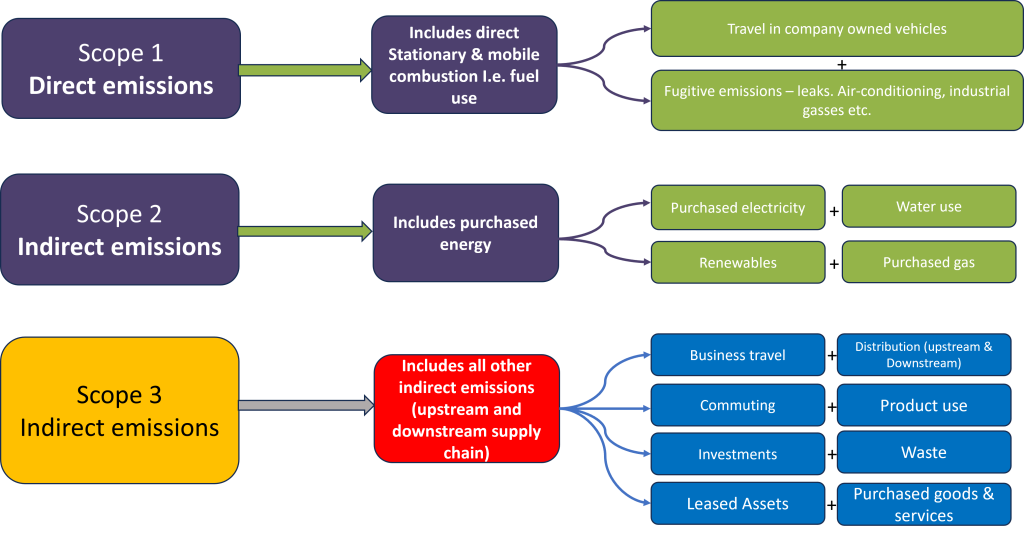The Greenhouse Gas protocol provides the most widely recognised standards for greenhouse gas emissions reporting, categorising emissions into three scopes (1 , 2 & 3). These scopes cover all of the direct and indirect emissions caused by organisational activity. Scope 1 (direct emissions) covers fuel combustion, company vehicles and fugitive emissions. Scope 2 (indirect emissions) covers purchased energy such as gas and electricity. Finally, scope 3 covers all other indirect emissions (not found in scope 2) including activities linked to purchased goods and services, business travel, commuting, waste disposal, distribution and investments. It is important to note that scope 3 includes both upstream and downstream activities. For example, upstream waste is waste generated in operations, whereas downstream waste is end of life treatment of sold products, both would be included. Figure 1 below provides an illustration of what is included in each scope

Figure 1 simplified Greenhouse Gas emissions scopes
Whilst it can be relatively easy to measure scopes 1 and 2 and make changes accordingly to reduce impact, it can be a difficult and daunting task to measure scope 3 emissions. Scope 3 can make up approximately 80 – 95%[1] of a company’s greenhouse gas emissions, covering a large range of operations outside of the company’s control. Collecting data for scope 3 often has significant challenges that result from global supply chain complexity which leads to difficulties in obtaining data from suppliers. Due to the enormity of supply chain processes in modern business practice, knowing where to stop the calculation can also be difficult, therefore clear boundaries must be drawn to achieve clarity on what can be measured and reported on for individual businesses. Each business will have different requirements and the core environmental issues for businesses should be outlined and decided upon during the assessment stage. In order to ensure that a clear process is set out from the beginning, the following structure outlined in Figure 2 is advised to maintain a clear method of analysis.

Figure 2. The process for calculating scope 3 emissions
Although there are difficulties associated with scope 3 data collection and reporting, it is important to acknowledge the vast amount of greenhouse gasses that can be attributed to upstream and downstream indirect emissions sources within an organisation. This aspect of emissions reporting although not mandatory (in most cases), should not be disregarded. The significant impacts that scope 3 emissions have are relevant and assessment can be achieved via clear boundary setting and acknowledging what reasonable measurements for an organisation might look like. This includes understanding the supply chain and partnering effectively with suppliers in order to encourage collaborative data sharing approaches. For scope 3, clear targets with meaningful, timebound actions are critical to illustrate progress and encourage others to do the same. Engaging suppliers is an important step in facilitating this process, embedding a culture of sustainability and maximising communication. Celebrating the success achieved is also an important factor for continued engagement. Storytelling used to encourage action can be an extremely effective tool for increasing scope 3 data sharing engagement. Once success is seen, often others want to share success and replicate the positive outputs.
Complete assessment of all indirect emissions is arguably the best course of action, but this is not always possible due to missing data. Therefore, smaller steps made to implement elements of scope 3 emissions within the carbon footprinting process can provide a strong base for further reporting as and when an organisation can obtain information. This might be: mapping the supply chain and gathering data on a small selection of purchased goods; targeting a small selection of suppliers; factoring in working from home, or; calculating impacts of business travel and commuting. The most important element in scope three emissions is to ‘make a start’. The data will not be perfect after a first assessment and calculation, but the data that is collected can lead to vast improvements for subsequent calculations (as illustrated in the improvement phase in Figure 2). By having a starting point, the calculation can grow, and it can shed light on additional data that an organisation should be collecting in order to expand scope three calculations and improve accuracy.
Without doubt, measuring scope 3 emissions can have significant benefits. It can help organisations to understand their value chain, strengthen supply chain relationships, improve collaboration and potentially lead to cost savings and new opportunities. In addition, it can provide a significant competitive advantage when working with larger organisations who are steadily moving towards wider reporting on scope 3. As larger companies demand higher sustainability requirements, it is becoming essential to measure impacts that go beyond the basics in order to ensure growth. One of the key aspects to note is that businesses do not have to do everything, all at once, in order to make a meaningful commitment and contribution to scope 3 reporting. It is down to the individual organisation to decide on the best course of action. Will you boldly go into scope 3 or take those baby steps to achieve big impacts in carbon emissions reduction?
[1]https://assets.publishing.service.gov.uk/media/652ea475697260000dccf9db/scope-3-emissions-in-the-uk-reporting-landscape.pdf
Credibly Green provide technical advice to clients on all things carbon and sustainability. See www.crediblygreen.com or call 01746 552423 or email support@crediblygreen.com




